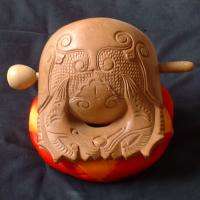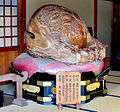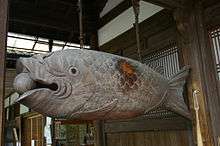Wooden fish
A wooden fish -- also known as a Chinese temple block or wooden bell[1][2] -- is a wooden percussion instrument that originated from East Asia.[3] It is used by monks[4] and lay people in the Mahayana Buddhist tradition. It is often used during rituals usually involving the recitation of sutras, mantras, or other Buddhist texts. The wooden fish is mainly used by Buddhist disciples in China, Japan, Korea, and other East Asian countries use it in religious ceremonies. It may also be referred to as a Chinese block, Korean block or, rarely, as a skull.[5] In most Zen/Ch'an Buddhist traditions, the wooden fish serves to keep the rhythm during sutra chanting. In Pure Land Buddhism, it is used when chanting the name of Amitabha.
| Wooden fish | |||||||
|---|---|---|---|---|---|---|---|
 Wooden fish | |||||||
| Chinese name | |||||||
| Traditional Chinese | 木魚 | ||||||
| |||||||
| Tibetan name | |||||||
| Tibetan | ཤིང་ཉ། | ||||||
| |||||||
| Vietnamese name | |||||||
| Vietnamese | mộc ngư mõ | ||||||
| Korean name | |||||||
| Hangul | 목탁 | ||||||
| |||||||
| Japanese name | |||||||
| Kanji | 木魚 | ||||||
| |||||||
| Manchu name | |||||||
| Manchu script | ᡨᠣᡴᠰᡳᡨᡠ | ||||||
| Romanization | toksitu | ||||||
The Taoist clergy has also adapted the wooden fish into their rituals.[6]
Types of wooden fish
There are two kinds of wooden fish. Today the most commonly used one is the traditional instrument that is round in shape and often made out of wood,[7] but sometimes other materials are used as well; this form is actually a later development from the original. The fish is hollow with a ridge outside of the wooden fish to help provide the genuine hollow sound when striking the fish; the instrument is similarly shaped like a jingle bell. The sound can differ among wooden fish depending on the size, type of wood used, and how hollow the wooden fish is. The instrument is carved with fish scales on its top, and a carving of two fish heads embracing a pearl on the handle (to symbolize unity), hence the instrument is called a wooden fish for that reason. In Buddhism the fish, which never sleeps, symbolizes wakefulness. Therefore, it is to remind the chanting monks to concentrate on their sutra. Often the mallet used to strike the fish has a rubber coated tip to provide a muffled, but clear sound when struck. A simplified form is given in the temple block.
Wooden fish come in many sizes and shapes, ranging from 150 millimetres (5.9 in), for laity use or sole daily practice, or to 1.2 metres (3.9 ft) for usage in temples. Wooden fish are often (in Chinese temples) placed on the left of the altar, alongside a bell bowl, its metal percussion counterpart. Wooden fish often rest on a small embroidered cushion to prevent damage and unpleasant knocking sounds caused from the fish lying on the surface of a hard table or ground, as well as to avoid damage to the instrument.
The Korean version of a wooden fish is simpler in shape and no design is carved onto the fish. It is more oblong in shape. It has a handle for easy carrying during portable uses. The Korean versions of a wooden fish are different in the sense that they provide a deeper, more wooden-like hollow sound when struck.
An updated version of traditional wooden fish are so-called granite blocks. Despite the name, they are not made of stone, but of plastic.
Original

The original type of wooden fish is literally in the shape of a fish. Along with a large temple bell and drum, It is found suspended in front of Buddhist monasteries. When proceeding with various duties (such as eating, lectures, or chores), a monk and a supervisor utilize the instrument to call all monastics to go to their tasks. Historically, this was the first wooden fish developed, which gradually evolved into the round wooden fish used by Buddhists today. One of the most noted examples is at the temple of Manpuku-ji.
Legends & nomenclature

Many legends describe the origin of the wooden fish, which take place in China. One legend says that a monk went to India to acquire sutras. On his way to India, he found the way blocked by a wide, flooding river. There appeared neither bridge nor boat.[8]
Suddenly, a big fish swam up. It offered to carry the monk across the river. The fish told the monk that it wanted to atone for a crime committed when it was a human. The fish made a simple request, that on the monk's way to obtain sutras, to ask the Buddha to guide the fish on a method to attain Bodhisattvahood.
The monk agreed to the fish's request and continued his quest for seventeen years. After getting the scriptures, he returned to China via the river, which was flooding again. As the monk worried about how to cross, the fish came back to help. It asked if the monk had made the request to the Buddha. To the monk's dismay, he had forgotten. The fish became furious and splashed the monk, washing him into the river. A passing fisherman saved him from drowning, but unfortunately the sutras had been ruined by the water.
The monk went home full of anger. Filled with anger at the fish, he made a wooden effigy of a fish head. When he recalled his adversity, he beat the fish head with a wooden hammer. To his surprise, each time he beat the wooden fish, the fish opened its mouth and vomited a character. He became so happy that, when he had time, he always beat the fish. A few years later, he had got back from the wooden fish's mouth what he had lost to the flood.
Uses
.jpg)
The wooden fish is often used for rites of death and resurrection.[1] During funerals, people may walk in processions while sounding wooden fishes in a slow and unison rhythm.[1] Other purposes may include prayers for rain.[1] In Confucianism, the wooden fish is struck at specific intervals to signify certain stages of ceremonies at temple.[1] In Buddhism, it is struck during chants of Buddha's name.[1]
The wooden fish symbolizes wakeful attention.[1] It can also symbolize wealth and abundance.[1]
Temple blocks can be heard in Leroy Anderson's The Syncopated Clock. Olivier Messiaen used them in his only symphony, Turangalîla, and his only opera, Saint-François d'Assise. Harrison Birtwistle calls for four temple blocks in his 2008 opera The Minotaur, Magnus Lindberg calls for five in Seht die Sonne, and Pierre Boulez for one in Notations I-IV. Leonard Bernstein, George Benjamin and David Horne also used it in their compositions. Pink Floyd's Nick Mason used temple blocks on the songs "The Gnome" and "The Scarecrow" from their debut album "The Piper at the Gates of Dawn" and on the single "Julia Dream". The rock band Rush featured temple blocks in their songs "Xanadu" and "The Trees," played by drummer Neil Peart.
Gallery
 A Korean styled Moktak (Wooden fish)
A Korean styled Moktak (Wooden fish)- Intricate carvings on this huge Mokugyo, over 3-foot (0.91 m) wide.
 One of the largest wooden fish in the world, located at Hasedera in Kamakura, Japan
One of the largest wooden fish in the world, located at Hasedera in Kamakura, Japan An original type of wooden fish at Manpuku-ji, Uji, Japan
An original type of wooden fish at Manpuku-ji, Uji, Japan Head of the wooden fish at Manpuku-ji, Uji, Japan
Head of the wooden fish at Manpuku-ji, Uji, Japan
See also
References
- Blades, James (1992). Percussion instruments and their history. Westport: Bold Strummer. p. 115. ISBN 9780933224612.
- Adato, Joseph; Judy, George (1985). The Percussionist's Dictionary: Translationas, Descriptions and Photographs of Persussion Instruments from Around the World. Alfred Music Publishing. p. 12. ISBN 9781457493829.
- "Percussion instrument "wooden fish" - MusicBrainz". musicbrainz.org. Retrieved 2020-06-08.
- Museum, National Palace (2013-06-01). "Origins and Developments of the Lingnan School of Painting_Monk and Wooden Fish Drum". National Palace Museum. Retrieved 2020-06-08.
- Blades, James (1992). Percussion Instruments and Their History. Bold Strummer. p. 391. ISBN 9780933224612.
- Davison, Gary Marvin; Reed, Barbara E. (1998). Culture and Customs of Taiwan. Greenwood Publishing Group. ISBN 978-0-313-30298-5.
- "Amazon.com: BQLZR Wooden Fish Shape Guiro Percussion Instrument with Scraper Kindergarten Early Learning Wooden Guiro: Musical Instruments". www.amazon.com. Retrieved 2020-06-08.
- "Wooden Fish Legend".